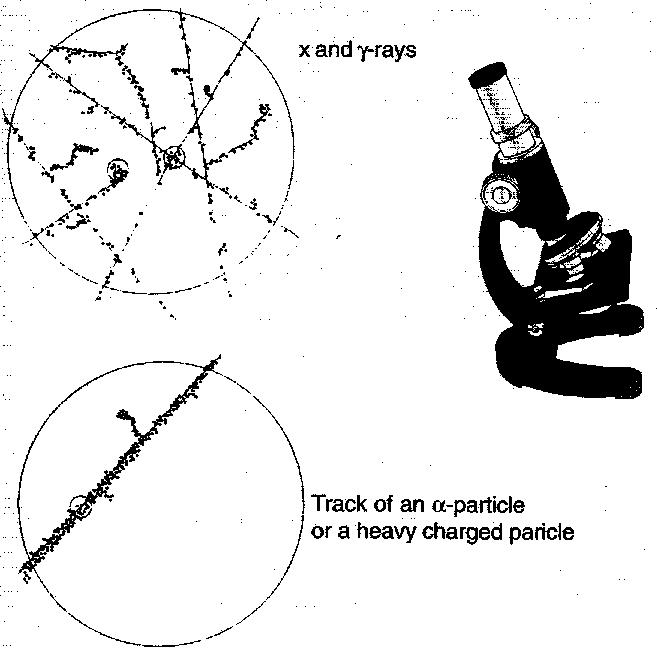
4. Equivalent Dose
The equivalent dose is a dose of irradiation of a living organism by mixed or unknown types of ionizing radiation which biological efficiency is equivalent to the unit of absorbed dose.
When a biological system is exposed to ionizing radiation, molecules are ionized and excited. For a particular material, all types of radiation yield the same kinds of damaged molecules. However, there are differences with regard to the distribution of ionized and excited molecules along the track of a particle or photon.
Consider a very powerful microscope that makes it possible to "see" the molecules in a system. If a microscope is used when the system is exposed to radiation, differences will be observed in the distribution of ionizations produced by the radiation (see Figure 4.1). X-rays, β-particles and γ-rays strike the molecules rather sporadically - as indicated in the upper part of Figure 4.1. The small dark dots represent ionized molecules. For α-particles the situation is different. The ionizations are deposited along a single linear track. The molecules in the center of the track (the track core) are ionized, or hit. Sparse ionization along the γ-ray track is due to a low linear energy transfer (LET) while the dense ionization of the α-particle is due to high LET.
Even though the number of ionized molecules, and consequently the energy deposition, within the two circles is the same ( (the absorbed dose is a total quantity of ionizing radiation energy which the absorbed dose is absorbed by object of irradiation) is the same), the distribution of the energy deposition (i.e., the LET) is different.
The biological effect depends upon the LET of the radiation, i.e., the distribution of the absorbed energy in other words the transfer of energy of ionizing radiation on the all length of path of a particle or a photon. |

Ionizations from different types of radiation as seen in a very powerful microscope
FIG 4-1.
The Figure indicates how the distribution of absorbed energy in a system (for example an animal cell) might look after different types of radiation have passed through. The upper circle (field of view) contains tracks produced by x- and γ-ray absorption and the lower circle contains the track of α-particle. Each dot represents an ionized molecule. The number of dots within the two circles is the same, indicating the same radiation dose. However, note that the distribution of dots (ionizations) is quite different. The top is an example of low LET (linear energy transfer) and the bottom is an example of high LET.
For biological effects, such as cell death, cancer induction, and genetic damage, the effect is larger when the radiation energy is deposited within a small region. This is calculated by introducing a radiation weighting factor (wR).
WR is related to the relative efficiency of the radiation in producing a biological effect, and is given relative to high energy x-rays and γ-rays where wR is set equal to 1. For α-particles, neutrons and other particles, wR is larger than 1. This indicates that most biological effects depend on the spatial distribution of energy along the track (i.e. the LET or Linear Energy Transfer). In radiation protection, a wR of 20 is currently used for α-particles where as for neutrons the factor varies from 5 to 20, depending upon their energy.
When the physical dose, measured in gray, is multiplied by wR, the biological effective dose is calculated. This product is called the equivalent dose. The unit for equivalent dose is the sievert (abbreviated Sv), named after the Swedish scientist R.M. Sievert.
-
H = wR·D
H is the equivalent dose in Sv and D is the dose in Gy.
In order to evaluate the biological effect of radiation we apply the sievert. The crux of the matter is the value of wR. A number of experiments have been performed with the aim of getting more information on wR. This parameter is frequently of crucial importance.
